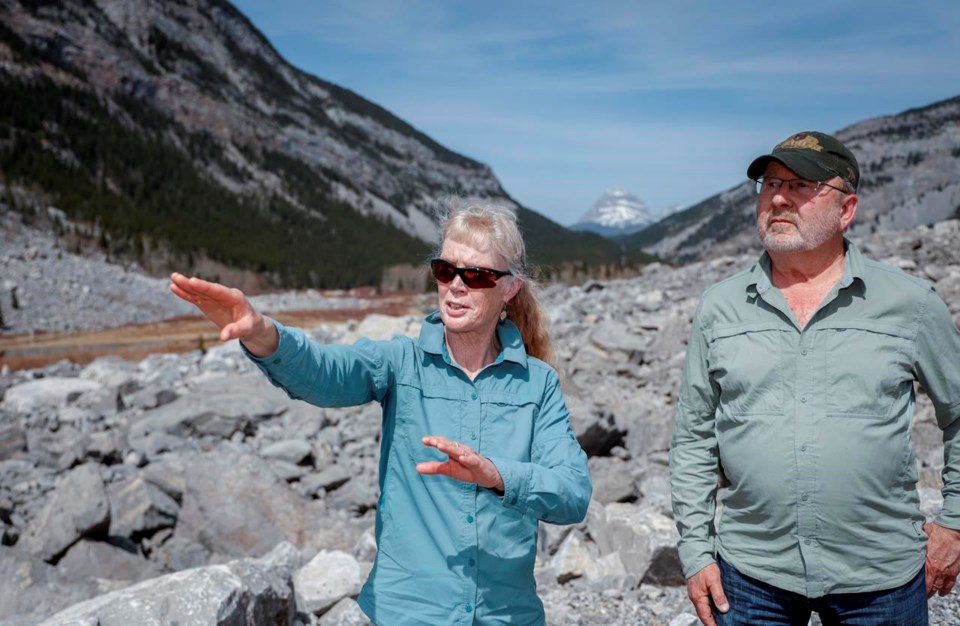FRANK, ALBERTA — Some residents of Crowsnest Pass say a planned twinning of Highway 3 through the community in southwestern Alberta will amount to a "desecration" of the site of Canada's deadliest rock slide.
It was 120 years ago that 82 million tonnes of rock fell from the summit of Turtle Mountain into the Crowsnest River valley below.Â
The slide lasted a mere 90 seconds, but in that short time at least 92 people were killed and the southeastern corner of the coal mining town of Frank, Alta., disappeared.Â
Highway 3, which connects Alberta with southeastern СŔ¶ĘÓƵ, weaves its way through the giant grey limestone boulders -- some as big as school buses, others the size of small houses.Â
A twinning of the busy corridor has been discussed for 50 years and it now appears to be a reality with final approvals granted and a two-year engineering study underway. Part of the superhighway would include a community access road directly through the rockslide connecting the tiny mining towns of Bellevue, Frank and Blairmore.
"It is the desecration of a historic feature and I think 'what if we decided to put a highway through residential schools?' We know the Titanic is sacred. Are we going to cut the Titanic in half?" asked David McIntyre, who along with his wife, Monica Field, were former managers of the Frank Slide Interpretive Centre.
"I think we'd know some places are sacred. I don't know why we don't think this one is."
Field said it was only Manitoba Avenue, which included miners' cottages, a livery, a shoe shop and mining buildings, that was destroyed. But since only about a dozen bodies were recovered, where the rest are is anyone's guess.
"There was a ranch here," Field said pointing to a pile of rocks near the Crowsnest River. "But we don't know where and there were rumours there were 50 men camped on the river looking for work.
"When people say if we dig up the highway right here that there won't be any people under, nobody can say that. Nobody."
Both Field and McIntyre are angry that two historical designations meant to protect the sanctity of the Frank Slide area, which is three square kilometres in size, are being ignored.
"The acts are there to protect the slide and for 50 years they did. And suddenly we say 'I guess that doesn't matter because speed is more important than historical designations,'" McIntyre added.
"It’s time, they say, to dig up the Frank Slide’s dead, time to spend hundreds of millions to transform the Crowsnest River valley into a high-speed off-ramp into British Columbia."
McIntyre would prefer the 45-kilometre stretch of Highway 3 to the СŔ¶ĘÓƵ boundary be designated the Crowsnest Heritage Highway focusing on the scenery and the history of the region.Â
The concerns about the Frank Slide aren't a surprise to Blair Painter, the mayor of Crowsnest Pass.
"There's a proposed new road to be pushed through the slide, which is definitely concerning. The west end of the slide is deemed to be a graveyard and people definitely have concerns about it. Plus, it's a national historic site and disturbing it doesn't sit well with most people," Painter said in an interview.
"It doesn't sit well with me, but I'm open to suggestions on how they're going to do it. Right now, it's going into an approximately two-year engineering study and I'm waiting to see the results of that."
Painter said the addition of traffic lights on the current highway has improved safety for pass residents. He said there are also worries the expanded highway may cut small communities off from potential tourism or business traffic. Â
Mike Long, a spokesman for the provincial Transportation and Economic Corridors Ministry, said there has been extensive engagement.Â
"Transportation and Economic Corridors is aware of sensitivity of Frank Slide historic site, and the current plan minimizes the impact to the site," he wrote in an email.Â
"As the project moves forward to the detailed design phase, a review of the functional plan always occurs, which may result in slight refinements in the final design."
Painter said there's no denying the project is going ahead. Â
"It's gazetted and stamped by the government and the route has been chosen. It's just a matter of trying to make it work," he said.
He said he has met with Alberta transportation officials and is hoping there may be some way to at least tinker with the final project to lessen the concerns.
"This highway has been talked about since the late '60s, so long-term residents here have heard it and heard it and heard it and don't believe it and now we've come to the point that it's reality."Â
This report by The Canadian Press was first published May 8, 2023.
Bill Graveland, The Canadian Press




